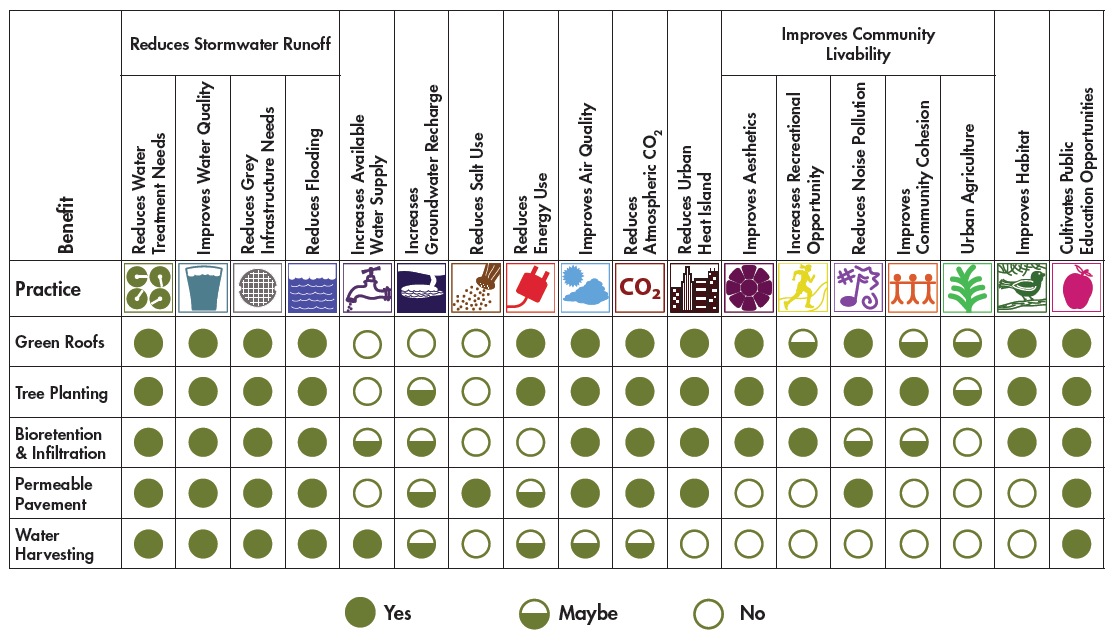THE CENTER FOR NEIGHBORHOOD TECHNOLOGY
What Is Green Infrastructure & Why Does It Matter?
Green infrastructure (GI) is a network of decentralized stormwater management practices, such as green roofs, trees, rain gardens and permeable pavement, that can capture and infiltrate rain where it falls, thus reducing stormwater runoff and improving the health of surrounding waterways. While there are different scales of green infrastructure, such as large swaths of land set aside for preservation, this guide focuses on GI’s benefits within the urban context.
The ability of these practices to deliver multiple ecological, economic and social benefits or services has made green infrastructure an increasingly popular strategy in recent years. (See Case Study section.) In addition to reducing polluted stormwater runoff, GI practices can also positively impact energy consumption, air quality, carbon reduction and sequestration, property prices, recreation and other elements of community health and vitality that have monetary or other social value. Moreover, green infrastructure practices provide flexibility to communities faced with the need to adapt infrastructure to a changing climate.
Why This Guide?
Although valuation of green infrastructure’s monetary benefits has advanced considerably in recent years, it is still a developing field. The EPA publication Reducing Stormwater Costs through Low Impact Development (LID) Strategies and Practices (2007) documented the comparative construction costs of green infrastructure practices in residential construction but did not explore performance benefits. While numerous published studies address either the benefits coming from one type of practice, such as energy implications of green roofs, or the collective impacts of a single practice, such as urban forestry’s impact on water, energy, and other elements, such studies do not achieve a cumulative assessment of multiple benefits.
Green infrastructure’s value as a municipal or private investment depends in part on its effects beyond water management and thus upon a community’s ability to model and measure these additional values. Short of conducting an intensive study and calculation of actions in a specific community, municipalities have generally lacked the tools to determine green infrastructure’s multiple benefits. As such, defining or measuring the extent of green infrastructure’s multiple benefits has remained a challenge. While a number of cities have begun to explore GI within their own municipal infrastructure programs, no general method for estimating or documenting such benefits has yet emerged.
Due to these gaps in information and methodology, decision making regarding stormwater infrastructure investments has generally lacked recognition of the monetary benefits that GI provides communities. With limited ability to quantify GI’s benefits, municipalities have often favored single-purpose grey infrastructure projects. However, any cost-benefit analysis comparing grey infrastructure with green infrastructure would be incomplete without factoring in the multiple benefits green infrastructure can provide.
Purpose of the Guide
This guide distills key considerations involved in assessing the economic merits of green infrastructure practices. It examines the steps necessary to calculate a variety of performance benefits gained by implementing GI strategies and then, where possible, demonstrates simplified illustrative examples that estimate the magnitude and value of these benefits.
In clarifying how to assign value to potential green infrastructure benefits, this guide can assist decision-makers in evaluating options for water management. A more clear view of GI’s values will help communities decide where, when and to what extent green infrastructure practices should become part of future planning, development and redevelopment.
About The Center for Neighborhood Technology
www.cnt.org
“Founded in 1978, the Center for Neighborhood Technology has been a leader in promoting more livable and sustainable urban communities. In fact, our work focused on sustainable development before the term became as popular as it is today. As a creative think-and-do-tank, we research, invent, and test urban strategies that use resources more efficiently and more equitably.”
Tags: CNT, GI, Green Infrastructure, The Center for Neighborhood Technology







 RSS Feed
RSS Feed